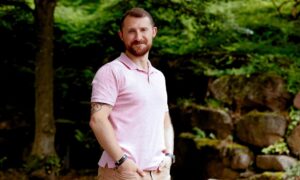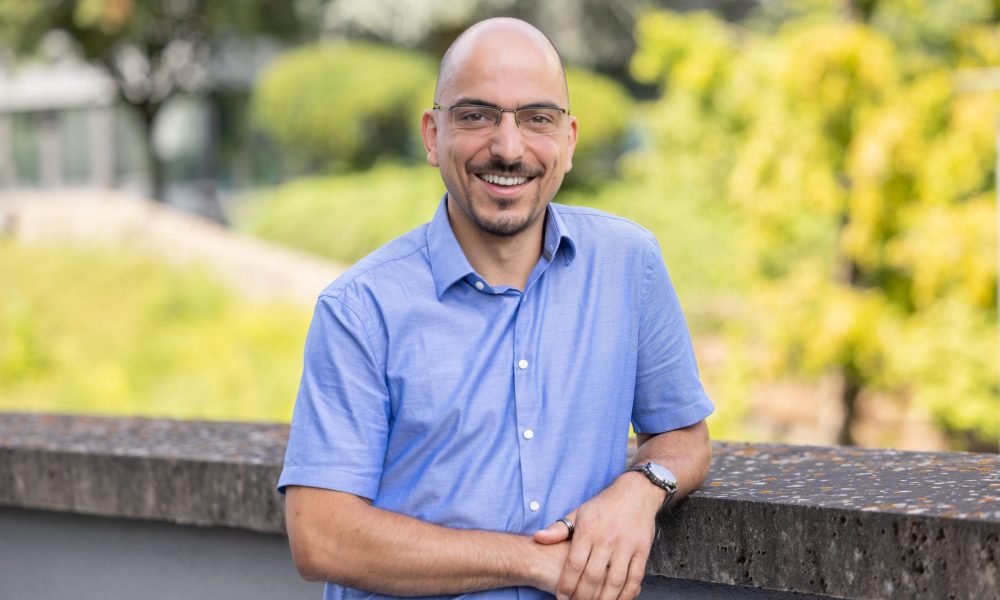
Read the latest Issue
Renato Alves talks about his time at EMBL, the Bio-IT project, his wishes for EMBL in its anniversary year, and how a passion for night hikes and stargazing led to the creation of EMBL’s astronomy club

Bio-IT is an open and knowledgeable community of researchers and support staff, united by a shared goal of improving the quality of the science done at EMBL and beyond. It aims to build, support, and promote computational biology activity at EMBL. Some of its resources extend beyond research to support everyone at EMBL as reflected by its recent integration in the Data Science Center.
Renato Alves is a Senior Bioinformatics Community Manager. In his role, he supports the Bio-IT community in the four pillars of the Bio-IT project: Training and Consulting, Infrastructure, Community and Networking, and Information dissemination. In this interview, Renato shares more about his role, journey, hobbies, and his wishes for EMBL on its 50th anniversary.
My interest in (bio)computing topics dates back to high-school. I was fascinated by how computers could assist with all kinds of tasks, from maths to geography. I remember fondly pushing the limits of what was possible with my 3-colour Casio graphing calculator and taking the first steps in learning how to code with it. At that time, I had not yet heard about the vast world of bioinformatics. This introduction happened during university, but it was unfortunately difficult and dreadful, leading me to lose interest for a couple of years. There are many paths into bioinformatics and mine only revealed itself a few years later while working at the Instituto Gulbenkian de Ciência (IGC). There, my interest was re-ignited by seeing how biological research and computation could synergise.
My path at EMBL started as a PhD student in the Bork group, working on computational methods to integrate metagenomes and metatranscriptomes. Already back then, I was part of the Bio-IT community, contributing to initiatives such as the Python and R coding clubs, and many geeky discussions on the lively EMBL chat. Finding a thriving community of like-minded individuals was – to put it simply – awesome! Shortly before the end of my PhD, I found an opening in the Bio-IT project. Initially, I worked alongside Toby Hodges. More recently, I’ve been working with Lisanna Paladin, with whom I share the role and responsibilities of Community and Project Manager of the Bio-IT project. It has been a wonderful experience with never-ending challenges and successes. I have always enjoyed sharing and empowering others through knowledge, and in Bio-IT, I found the ideal structure to do so.
It’s not just important, it’s essential. The Bio-IT project is all about collaboration and community building. It brings together not only shared interests but also resources, creating bridges between different groups within and outside EMBL. One example is the Bio-IT taskforce meetings, where the community gathers to discuss, inform, and when applicable, decide on topics relevant to the future of the project. Collaboration is so much at the heart of the project that nearly every activity we develop involves more than one group or project – some at a European scale (ELIXIR), others global (The Carpentries, Open Life Sciences, GOBLET,…).
Collaboration is the only way to create a culture of openness built on sharing, mutual assistance, and growth, which is beneficial to everyone who engages with us. It is also with this mindset that we are able to support members of our community in their initiatives, providing a space where they can experiment while having our assistance on organisational matters.
Going through the pandemic, perhaps for different reasons than many others. At the time, I had just started working with Bio-IT. I was barely acquainted with what goes into Bio-IT’s activities when we all suddenly had to adapt to a new reality. Simultaneously, Bio-IT saw an enormous increase in demand for training and support. Gladly, thanks to our amazing community, we were able to move most activities online, and organise two of the biggest courses in Bio-IT’s history, with close to 70 participants each. All this happened within the first two months of the start of the COVID-19 crisis. In parallel, the EMBL chat quintupled its daily message exchange and the Grassroots consulting initiative was born, bringing together volunteers that provided assistance on a wide range of topics, meeting this sudden demand in support. This ability to respond and adapt quickly was only possible because Bio-IT was backed by a community eager to help. This is one of the unique features of this project and proved absolutely essential during that critical period.
Food is an obvious choice 😁, but I would say the people. There are many amazing, skilled, curious, creative, dedicated, kind, and generous people at EMBL. Without this diversity and the enthusiasm and passion they bring, my day-to-day work would be far less exciting. My colleagues Lisanna Paladin and Isabela Paredes-Cisneros are two of them. I consider myself very lucky to have them as teammates.
In my spare time, I used to dedicate a significant amount of energy to a wide range of open-source software projects. I always found it gratifying to engage with those communities and create things that others can build upon. This is perhaps my biggest passion and is reflected in my work as well. Nowadays, spare time is somewhat scarce, and there are only so many hours one can spend in front of a screen after the pandemic, so I tend to prefer sports and wandering in nature. Goofing around with musical instruments at home, a good book, and a futuristic anime are also great options.
It started with a hiking adventure in the middle of the night to Thingstätte to camp and watch a meteor shower by myself. My friends said I was crazy, to put it mildly; but soon enough, some of them started to join. We started night hiking at EMBL and shortly after, we had two telescopes to play around with. From there to the creation of the Astronomy club at EMBL took literally just a couple of nights.
As to my favourite objects, I would pick two. First, blazars, because I can’t wrap my head around their jet of particles travelling at nearly the speed of light, and second, Saturn, because it’s visible with most telescopes and manages to gather the most “Whoooaaaa!” reactions from those who never saw it live. You should definitely join us one night if you have never seen it.
I could make a joke about how a breach in the space-time continuum brought me where I am… but instead, I will highlight three aspects: the curiosity for the unknown, the challenges of reasoning over complex knowledge, and how the two together push the boundaries of what we consider or think is possible. In short, Science!
In our night sky observations, even on an average day, we count a few meteors – small fragments that ignite in the atmosphere producing light. Recently, our counts have been skewed by man-made satellites that also produce a blink effect when hit by the sun at certain angles. It is mind blowing to think that the first satellite was sent to space only 65 years ago. There are now over 10,000 of them up there, doing all kinds of things for us. Our current lifestyle would not be possible without them.
So next time you turn on the GPS on your wearable device or car, spare a thought about the ‘blinking stars’ guiding your way. Science brought us here and where it leads next is likely beyond my wildest imagination.
To me these are periods of reflection on what has been achieved, on what follows, but also on our shared cultural identity and the impact of our work on the society we live in. On EMBL’s anniversary, and EMBL being its people, I wish everyone ingenuity and brilliance to overcome any challenges, and introspective opportunities such as this one to collectively reflect upon and celebrate our achievements and successes.
Looking for past print editions of EMBLetc.? Browse our archive, going back 20 years.
EMBLetc. archive